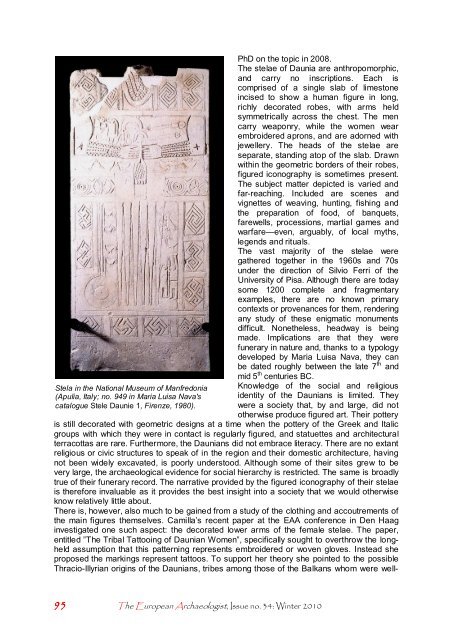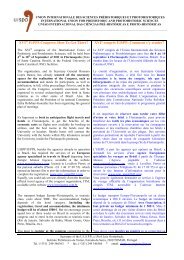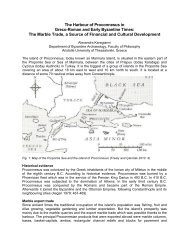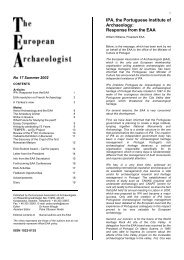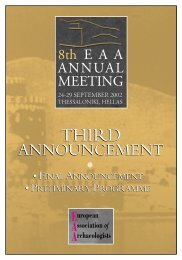TEA 34 - European Association of Archaeologists
TEA 34 - European Association of Archaeologists
TEA 34 - European Association of Archaeologists
You also want an ePaper? Increase the reach of your titles
YUMPU automatically turns print PDFs into web optimized ePapers that Google loves.
Stela in the National Museum <strong>of</strong> Manfredonia<br />
(Apulia, Italy; no. 949 in Maria Luisa Nava's<br />
catalogue Stele Daunie 1, Firenze, 1980).<br />
95<br />
95<br />
PhD on the topic in 2008.<br />
The stelae <strong>of</strong> Daunia are anthropomorphic,<br />
and carry no inscriptions. Each is<br />
comprised <strong>of</strong> a single slab <strong>of</strong> limestone<br />
incised to show a human figure in long,<br />
richly decorated robes, with arms held<br />
symmetrically across the chest. The men<br />
carry weaponry, while the women wear<br />
embroidered aprons, and are adorned with<br />
jewellery. The heads <strong>of</strong> the stelae are<br />
separate, standing atop <strong>of</strong> the slab. Drawn<br />
within the geometric borders <strong>of</strong> their robes,<br />
figured iconography is sometimes present.<br />
The subject matter depicted is varied and<br />
far-reaching. Included are scenes and<br />
vignettes <strong>of</strong> weaving, hunting, fishing and<br />
the preparation <strong>of</strong> food, <strong>of</strong> banquets,<br />
farewells, processions, martial games and<br />
warfare—even, arguably, <strong>of</strong> local myths,<br />
legends and rituals.<br />
The vast majority <strong>of</strong> the stelae were<br />
gathered together in the 1960s and 70s<br />
under the direction <strong>of</strong> Silvio Ferri <strong>of</strong> the<br />
University <strong>of</strong> Pisa. Although there are today<br />
some 1200 complete and fragmentary<br />
examples, there are no known primary<br />
contexts or provenances for them, rendering<br />
any study <strong>of</strong> these enigmatic monuments<br />
difficult. Nonetheless, headway is being<br />
made. Implications are that they were<br />
funerary in nature and, thanks to a typology<br />
developed by Maria Luisa Nava, they can<br />
be dated roughly between the late 7 th and<br />
mid 5 th centuries BC.<br />
Knowledge <strong>of</strong> the social and religious<br />
identity <strong>of</strong> the Daunians is limited. They<br />
were a society that, by and large, did not<br />
otherwise produce figured art. Their pottery<br />
is still decorated with geometric designs at a time when the pottery <strong>of</strong> the Greek and Italic<br />
groups with which they were in contact is regularly figured, and statuettes and architectural<br />
terracottas are rare. Furthermore, the Daunians did not embrace literacy. There are no extant<br />
religious or civic structures to speak <strong>of</strong> in the region and their domestic architecture, having<br />
not been widely excavated, is poorly understood. Although some <strong>of</strong> their sites grew to be<br />
very large, the archaeological evidence for social hierarchy is restricted. The same is broadly<br />
true <strong>of</strong> their funerary record. The narrative provided by the figured iconography <strong>of</strong> their stelae<br />
is therefore invaluable as it provides the best insight into a society that we would otherwise<br />
know relatively little about.<br />
There is, however, also much to be gained from a study <strong>of</strong> the clothing and accoutrements <strong>of</strong><br />
the main figures themselves. Camilla’s recent paper at the EAA conference in Den Haag<br />
investigated one such aspect: the decorated lower arms <strong>of</strong> the female stelae. The paper,<br />
entitled ”The Tribal Tattooing <strong>of</strong> Daunian Women”, specifically sought to overthrow the longheld<br />
assumption that this patterning represents embroidered or woven gloves. Instead she<br />
proposed the markings represent tattoos. To support her theory she pointed to the possible<br />
Thracio-Illyrian origins <strong>of</strong> the Daunians, tribes among those <strong>of</strong> the Balkans whom were well-<br />
The <strong>European</strong> Archaeologist, Issue no. <strong>34</strong>: Winter 2010


